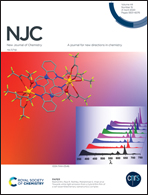A coumarin based fluorescent chemodosimeter for phosgene gas detection instantaneously in solution and the gas phase†
Abstract
A coumarin based compound, 7-(diethylamino)-2-oxo-2H-chromene-3-carbaldehyde oxime (DCCO), has been developed as a visual fluorescent chemodosimeter for selective detection of highly toxic phosgene gas. DCCO exhibits absorption bands at 330 nm and 425 nm. In the presence of phosgene, the absorbance at 330 nm increases and the peak at 425 nm is shifted to 420 nm with decreasing absorbance accompanying a color change from yellow to colorless. The fluorescence intensity of the probe at 483 nm is enhanced in the presence of phosgene (λex = 425 nm) but nerve agents and other acid chlorides including trisphosgene could not induce any significant enhancement of the fluorescence. DCCO on interaction with phosgene is converted to the corresponding nitrile derivative, 7-(diethylamino)-2-oxo-2H-chromene-3-carbonitrile (DCC). The quantum yield has been increased 13 fold on conversion from DCCO to DCC. The fluorescence enhancement has been explained by the ICT mechanism, which has been supported by theoretical calculations. It exhibits a rapid response for naked eye detection of phosgene. DCCO has been used for the detection of phosgene in solution and the gas phase.



 Please wait while we load your content...
Please wait while we load your content...